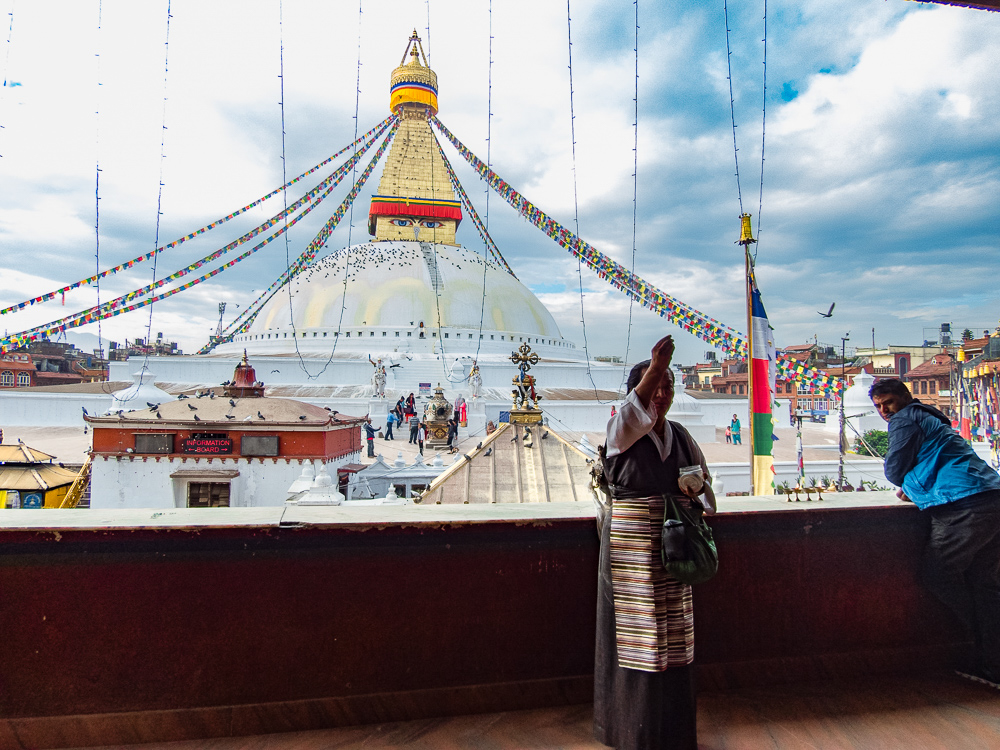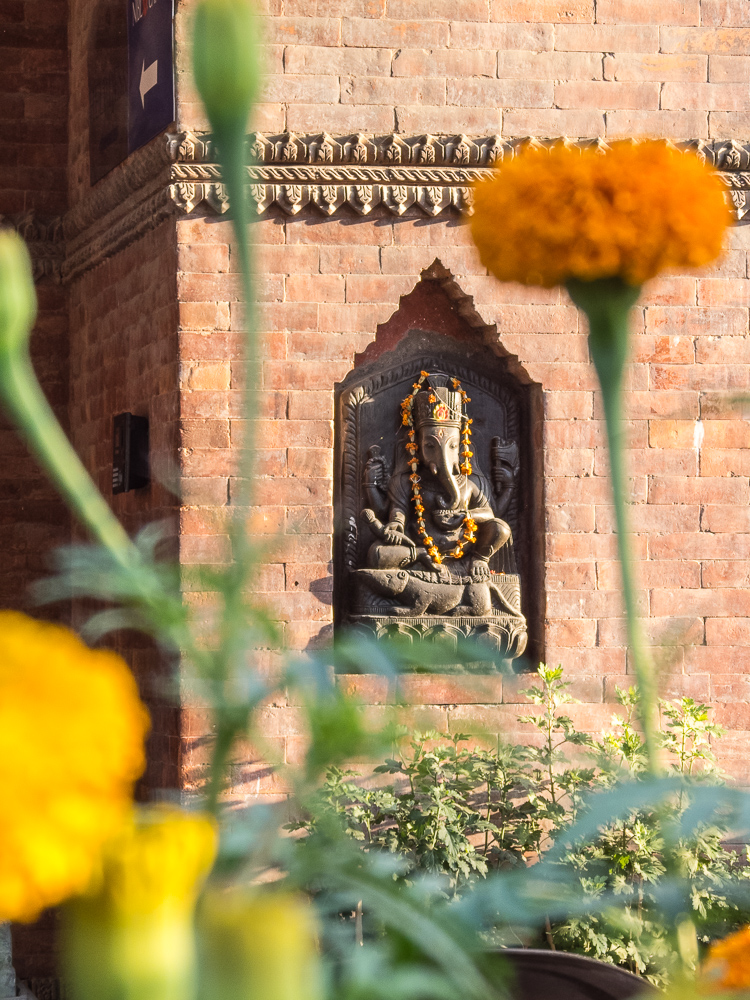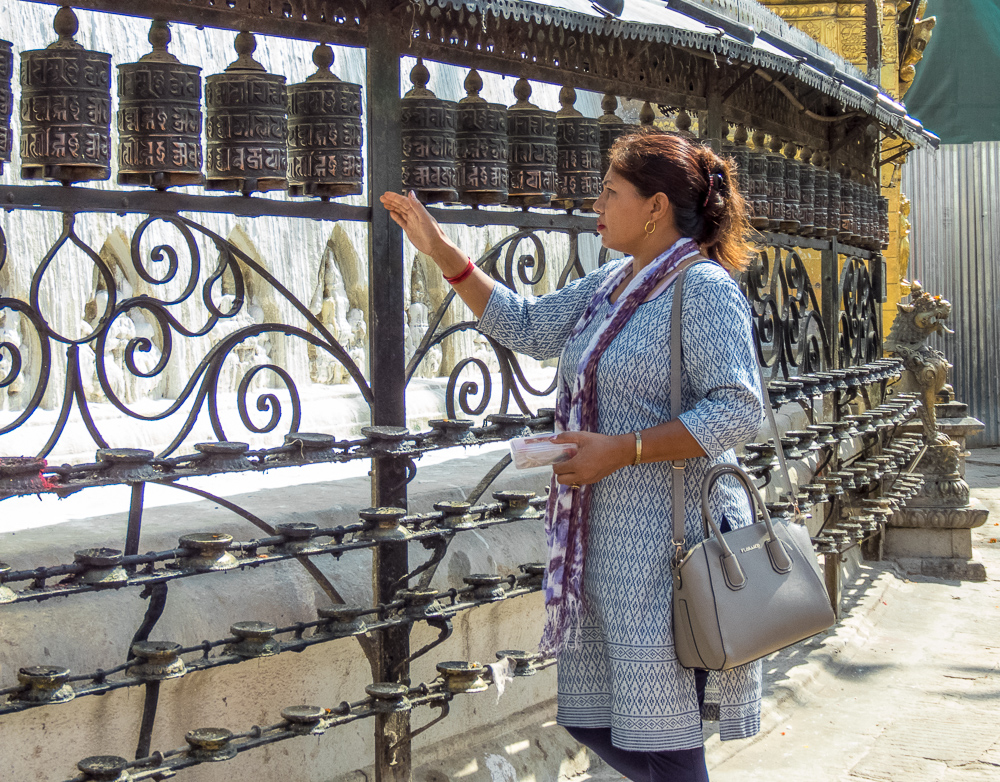We spent a morning with an extended visit to the famous Boudanath Stupa and the White Monastery including the Rangling Yeshi Institute on the grounds of the monastery.

Through friend connections we met a Jesuit priest and expert in comparative religions at the stupa for a tour. Among other things, he helped us understand a stupa is not a place you enter but a place you circle – always clockwise. In basic terms, it is a reliquary containing any number of small to large items in a small cave underneath the central pole holding the entire round mound up. The larger the pole, the deeper the relics are contained and the larger the circumference of the stupa. Prayers are said while turning every prayer wheel when passing and/or just saying them when continuously walking the circuit. One must complete a full loop to complete prayers which sets up a constant slow-motion scene to watch in the square.

In the case of this largest stupa in Nepal, there’s a courtyard just inside the prayer wheel level which houses multiple places to prostrate pray in a virtually athletic motion. Most prayers are a combination of 108 spoken mantras (personal or standard – most familiar is om mani padme hom) and physical movement of standing-drop-to-prone with a slide on wooden ground-level platforms. There are also gardens growing, primarily, marigolds and other items to either support the monks or provide unlimited offering supplies. And huge bags of rice are near most small idols housed in niches so one can grab a handful and offer it while making individual prayers.

Additionally, most stupa’s offer a place to insert relics or ashes in small containers of those one has lost making it a place of literal burial for at least a portion of one’s loved ones. The containers are small clay pots about the size of a shot glass which are pushed as far into small notches as one can reach. He told us the monks retrieve them periodically and place them further inside – but not as far as the Buddha relics – through narrow tunnels.
After the 2015 earthquake, it was determined while the outside structure was intact, the internal support pole of Boudanath was severely damaged requiring replacement. This gave a very rare opportunity to examine the architecture. First, however, they had to have five days of ceremonies to remove the relics storing them in another safe location for a year while repairs were begun. Before the new pole could be placed, they had to have another five days services to re-sanctify the stupa. Then the pole was set and the place was again declared holy while the remaining repairs were completed. Whew.
Then our expert guide provided us with a crash course in Newari Buddhism. He calls himself a religious ethnographer and he teaches Newar (Nepalese) Buddhism at the Yeshi Institute.

Newars are indigenous people and give their name to the country. Before the 18thc the country was all small principalities. A dynasty of leaders from the militarily strong city of Ghorka united western Nepal and then eyed the jewel of the Kathmandu valley – the center, then and now, of wealth and power. Before 1760, Nepal was only the Kathmandu Valley. The Malla line ruled from the 12thc and created the classic buildings and arts now revered. Officially the current geographic country has only been “Nepal” since 1920.
The Newars were always multi-ethnic and multi-religious (Hindu & Buddhist). And multi-caste. Regardless of religion one belonged at some level of the caste system.
Buddhism came here approx. 1st c BC. About the year 100 AD it began to decline. Then Islam became more important as it grew in both 800 and 1100 AD. It was easier for Islamists to wipe out monasteries and kill monks – the center of Buddhist life is built on a sense of a greater community and service. It was much harder to destroy the home-centered Hinduism. The only place Buddhism really survived regionally was the Kathmandu Valley. (Although it was well saved in Tibet and Asian island nations like Thailand).
Most Newari recognize both Hinduism and Buddhism as part of their heritage but only become distinctly one or the other the more “purist” they are up the caste chain with the Vajirai (Buddhist) and Brahmins (Hinduists) the height of orthodoxy.

A senior monk at the monastery briefed us on the lifestyle and answered questions about their practice. A Buddhist monk’s life goal is to recognize his practice and spirit and strengthen it. Teaching strengthens but meditation transforms. Balance is sought.
Music is a devotional offering. Sounds exist but yet don’t. You cannot touch a sound. And it reminds you to be only in the moment when a drum beat affects your heart or a hum passes your lips or a horn is blown. It is transitional. Sound is an offering and a reminder to self at the same time and, therefore, encouraged and celebrated as part of the practice. I found it comparable to the way the call and response is used in a Catholic mass or how music is used to be reflective after receiving communion in Christian churches. Be in the moment. Let the wave of peace pass through on the sounds reverberating in the space.

All the arts support prayers (puja) including sculptural ornaments, calligraphy, musical instruments and thanka, the sand paintings created for special rituals and recreated as 2-dimensional paintings for both practice and tourists. Monks are encouraged to use their gifts and learn their practice as part of their spiritual practice
We’re taking a small group to Nepal in October 2019. If you’re interested, please send us a note and we’ll send you some details.

